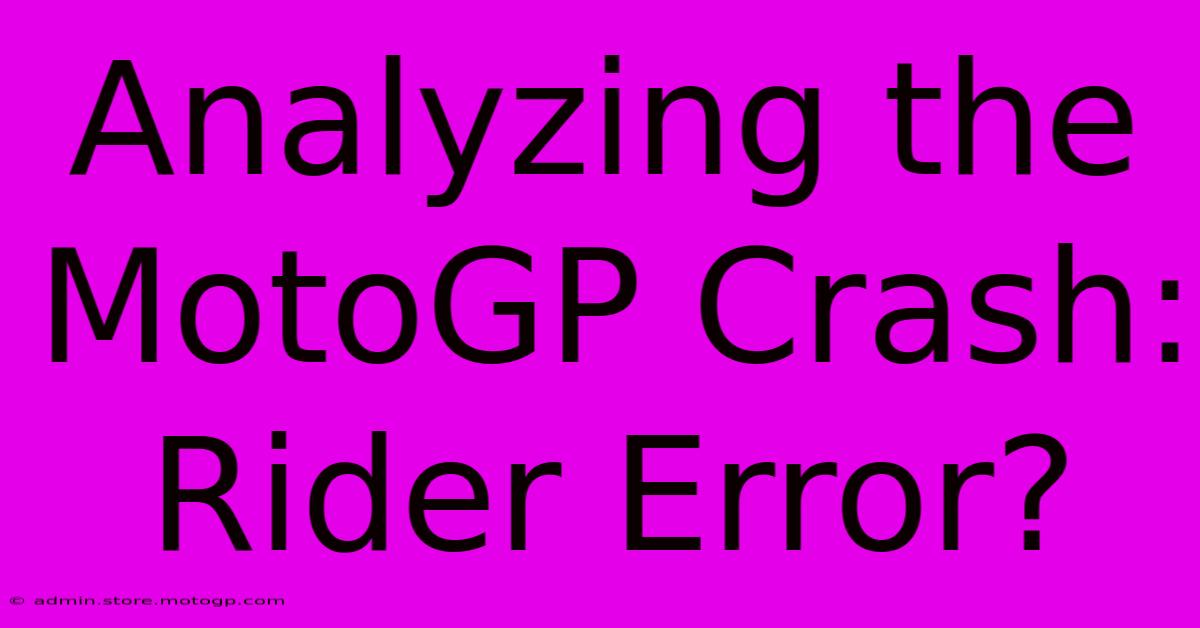Analyzing The MotoGP Crash: Rider Error?

Table of Contents
Analyzing the MotoGP Crash: Rider Error?
The roar of the engines, the blur of speed, the breathtaking skill… and then, the crash. MotoGP, a sport pushing the boundaries of human and machine capability, is inevitably punctuated by spectacular – and sometimes devastating – crashes. While mechanical failure can play a role, rider error is often the primary culprit. But how do we analyze these incidents and determine the root cause? This article delves into the factors contributing to MotoGP crashes and explores how to distinguish between rider error and other contributing elements.
Understanding the Complexities of a MotoGP Crash
Analyzing a MotoGP crash isn't simply about pointing fingers; it's a meticulous process requiring consideration of multiple intertwined factors. A seemingly simple mistake can have cascading consequences, making a definitive judgment difficult without a thorough examination. Let's break down the key elements:
1. The Rider's Role: Human Error Under Pressure
Rider error encompasses a wide spectrum of possibilities, including:
- Line choice: Incorrect racing line selection, especially in crucial corners, can lead to loss of control or collisions.
- Braking issues: Over-braking, under-braking, or improper brake application can cause instability and loss of traction.
- Throttle control: Incorrect throttle application, particularly during acceleration or corner exit, can result in wheelspin or loss of control.
- Body positioning: Incorrect body position on the bike can destabilize it, particularly during aggressive maneuvers.
- Decision-making: Poor judgment in overtaking maneuvers, reacting inappropriately to other riders, or misjudging track conditions can contribute significantly to crashes.
- Physical and Mental State: Fatigue, illness, or even psychological pressure can impair a rider's judgment and reaction time.
Identifying Rider Error: Careful review of onboard footage, telemetry data, and witness accounts is crucial in determining if rider error was a significant factor. Analyzing braking points, lean angles, throttle input, and the rider's body position relative to the bike can help pinpoint the exact moment the error occurred.
2. Mechanical Failures: When the Machine Fails
While rider error often takes center stage, it's crucial to remember that mechanical failures can also cause crashes. These might include:
- Tire failure: Punctures, blowouts, or excessive wear can lead to sudden loss of control.
- Brake failure: A failure in the braking system can render a rider powerless to slow down.
- Engine failure: An engine seizing or cutting out suddenly can result in a loss of power and control.
- Suspension malfunction: A problem with the suspension system can compromise stability and handling.
Distinguishing Mechanical Failure from Rider Error: Post-crash investigations often involve a detailed examination of the motorcycle to identify any mechanical problems. Telemetry data can also help reveal inconsistencies that might indicate mechanical failure.
3. External Factors: Beyond Rider and Machine
External factors can sometimes contribute to a crash, making the analysis even more complex:
- Track conditions: Oil spills, debris, or wet patches can dramatically affect traction and lead to accidents.
- Other riders: Collisions with other riders are a common cause of crashes in MotoGP.
- Weather: Rain, wind, or extreme temperatures can significantly impact track conditions and rider performance.
The Importance of Data Analysis
Modern MotoGP utilizes advanced telemetry systems that provide detailed data on various aspects of a bike's performance. This data, combined with video analysis, allows for a much more in-depth understanding of what happened during a crash. Factors such as speed, acceleration, braking forces, lean angles, and tire temperatures can all be analyzed to build a comprehensive picture of the incident.
Conclusion: A Multifaceted Investigation
Determining the cause of a MotoGP crash is a complex process that goes beyond simply assigning blame. It requires a careful and systematic analysis of rider performance, mechanical integrity, and external factors. By utilizing advanced data analysis techniques and considering all contributing elements, we can gain a deeper understanding of these high-speed incidents and work towards preventing future crashes. While rider error is often a significant contributing factor, it’s vital to conduct a thorough investigation to uncover all aspects leading to the incident, fostering improvements in rider safety and technological advancements.

Thank you for visiting our website wich cover about Analyzing The MotoGP Crash: Rider Error?. We hope the information provided has been useful to you. Feel free to contact us if you have any questions or need further assistance. See you next time and dont miss to bookmark.
Featured Posts
-
Moto Gp Qualifying Explained How The Grid Is Formed
Feb 21, 2025
-
F1 Ratings The Secret Weapon For Fantasy F1 Domination
Feb 21, 2025
-
Dominate The Grid Own A Race Winning Machine
Feb 21, 2025
-
Cota Gifts They Ll Actually Love
Feb 21, 2025
-
Moto Gp Sprint Race Results A Must See For Racing Fans
Feb 21, 2025
